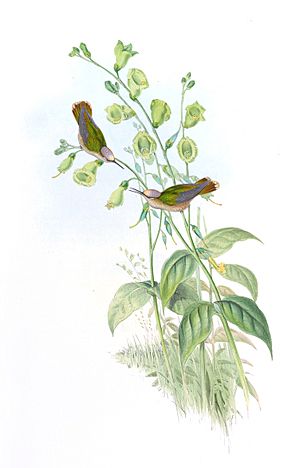Santa Marta blossomcrown facts for kids
The Santa Marta blossomcrown (Anthocephala floriceps) is a vulnerable type of hummingbird. It lives only in the Sierra Nevada de Santa Marta mountains in Colombia.
Quick facts for kids Santa Marta blossomcrown |
|
|---|---|
 |
|
| Conservation status | |
| Scientific classification | |
| Genus: |
Anthocephala
|
| Species: |
floriceps
|
 |
|
Contents
About This Hummingbird
The Santa Marta blossomcrown was once thought to be the same species as the Tolima blossomcrown. They were considered two types of the "blossomcrown" bird.
However, a study in 2014 showed they are very different. They have different genes and live in different climates. Because of this, bird experts around the world now agree they are two separate species. The Santa Marta blossomcrown is a unique species all on its own.
What Does It Look Like?
This hummingbird is about 8.4 cm (3.3 in) long. Both male and female birds have a straight, black beak.
The adult male has a light, creamy white forehead. The back of its head is a reddish-brown color. Most of its upper body is a shiny green. Its lower back and the feathers under its tail are rusty-colored. Its belly is a grayish-cream color.
Its tail is a bronzy-green. The tips of its tail feathers are creamy, and all but the middle two feathers have a black bar near the end. Young birds and females look similar to the adult male, but their whole head is brownish.
Where Does It Live?
The Santa Marta blossomcrown lives only in the Sierra Nevada de Santa Marta. This is an isolated mountain range in northern Colombia.
It makes its home in humid forests. It prefers old, untouched forests but can also live in older forests that have grown back. You can find it at heights between 400 and 1,700 m (1,300 and 5,600 ft) above sea level.
How It Behaves
Movement and Travel
Scientists believe the Santa Marta blossomcrown stays in one area. It does not travel far. However, they are not sure if it moves up or down the mountains during different seasons. More studies are needed to understand its movements.
What It Eats
This hummingbird usually looks for food low down in the forest. We do not know much about its diet. The only food source seen so far is nectar from banana flowers.
Reproduction and Life Cycle
The Santa Marta blossomcrown seems to breed in September and October. Male birds gather in special areas called leks. Here, they try to attract females for mating.
Not much else is known about how they raise their young.
What Does It Sound Like?
The song of the Santa Marta blossomcrown is a long series of repeated "tsip" notes.
Its Conservation Status
The IUCN (International Union for Conservation of Nature) has listed the Santa Marta blossomcrown as a Vulnerable species. This means it is at risk of becoming endangered.
It lives in a very small area. There are fewer than 2,500 adult birds left, and their numbers are decreasing. A lot of the forest where they could live has been cut down. The forests that are left are stable but broken into smaller pieces.
Some of its remaining home is protected. It lives in a national park and a special preserve owned by a foundation.
See also
 In Spanish: Colibrí cabecicastaño para niños
In Spanish: Colibrí cabecicastaño para niños


